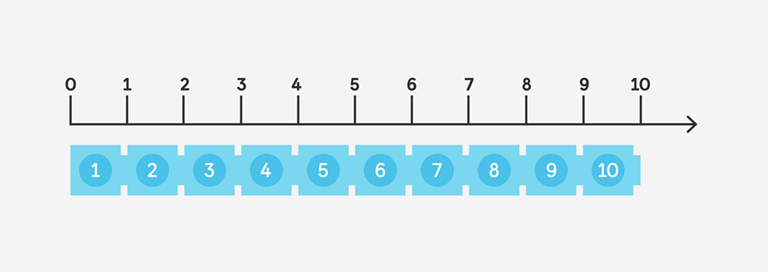Addition and subtraction Year 1 – differentiating for struggling learners (using a number line)
Editor’s Note:
This is an updated version of a blog post published on April 23, 2017.
A question arising frequently in the teaching of mathematics is how do we ensure engagement and progress for all learners? In this post, we examine how we differentiated learning practically for struggling learners in KS1 when teaching the chapter in the Maths — No Problem! textbook on addition and subtraction.
We began each lesson by showing pupils the problem on the board and asking them what they noticed; by prompting them to comment simply on what they could see, rather than focusing on any specific numbers, they were better able to understand the mathematics behind the problem.
A box of buttons – visualisation
For this topic, we used one of the In Focus tasks in the textbooks, which shows pupils a box of buttons and three additional buttons outside the box. Even those pupils who we had previously identified as struggling learners, were instantly able to notice that there were two groups of buttons in the picture and that we were going to need to find the whole.
Without pressure to count on or create a number sentence mentally which can, especially in a whole-class context, be a daunting prospect, they were able to focus on and even explain the mathematics in the problem. This gave them the chance to develop their understanding further and crucially, also allowed us as teachers to understand their thinking.
For example, there is a girl in one of the classes who finds one to one counting a struggle and is unable to confidently count to 10. When she is given a problem with an accompanying number sentence she panics, especially during a whole class input, and will often wait for one of her peers to answer for her. However, when we showed her the button problem and asked her to share what she could see and note how many there were, she was able to confidently tell the class that there were some buttons in the box and some buttons outside of the box and that she thought we might be able to work out how many buttons there were altogether. She was able to articulate her understanding of addition as adding two parts making a whole without the worry of counting or estimating.
Having determined as a class what we were going to be solving in the lesson and which (of several possible) methods we would be using, in this case a number line, we then moved on to solving the problem.

Prior to teaching this lesson, we felt confident that pupils would understand and be able to independently apply the skill of using a number line to ‘count on’. However, we found this was not the case! We noted that despite most pupils immediately solving addition problems by counting on in their head or on their fingers, they were unable to apply this on a number line. The first method pupils used was to circle both numbers within the number sentence and count the difference. Interestingly, they were not able to justify this method and had simply found (identified) the two numbers they could see in the picture. This could be corrected relatively easily as it was not a misconception, merely a lack of understanding.
Concrete materials
We clearly needed to make the concepts more concrete and began by using cubes and asking pupils to make the larger number and then add one cube at a time to create the total. In this way, they began to see their mental method as a physical representation. For those who struggled to make this connection we used the cubes against a number line, which allowed them to visualise and therefore understand the process. Our more advanced learners were asked to explain how they counted on in their head and we modelled this process on a number line allowing them to visualise the mathematics.
From this stage of concrete materials and visualisation as a class, we then moved on to more independent work using the available resources to help. For this lesson, we gave pupils cubes, a ten frame and a laminated number line. We found pupils liked to have their own number line and physically make the jumps along with a pen to find the answer. We would highly recommend having laminated number lines that pupils can use for each individual calculation; those who used the one in the workbook became confused as they had multiple calculations displayed on the same number line. Once pupils had access to their own number line and an understanding of the process, they could easily and independently complete the corresponding worksheet(s) in their workbooks.
A kinaesthetic solution
We then noticed that although some of our struggling learners were able to understand the process of adding using a number line, they were still ending up with different answers due to a lack of deeper understanding. This was because they were making the correct number of jumps but not making one jump match moving along one number line unit. Once again, we returned to using cubes but found pupils were still unable to make the connection. To rectify this, we made a larger number line and asked pupils to physically jump along while counting. Acting out the mathematics kinesthetically like this meant the learning became embedded and pupils began to develop a deeper understanding, which they then demonstrated in their workbooks.
In conclusion, through questioning and adaptation most pupils could understand how to relate their mathematical thinking to adding on a number line. However, we found that in subsequent lessons, when asked to independently add, they reverted to counting on. This was particularly evident in those we considered to be our more mathematically advanced learners, who can quickly and confidently count on and were therefore less receptive to different methods challenging and requiring them to think differently. This adds weight to the Maths — No Problem! approach, which advocates that advanced learners need their knowledge deepened, not extended.
Alex Laurie
Emily Downing
